Medication Safety
The old prescription bottle stowed away at the back of your medicine cabinet may seem like an innocuous concern, but its presence has serious consequences if mishandled. With prescription drug abuse a chief concern among many communities, proper medicine storage and disposal has proved critical to keeping individuals and families safe. According to the Office of National Drug Control Policy, more than 71,000 children 18 years and younger visit the emergency room each year for unintentional overdoses.
Medicine Storage
Try to keep all prescriptions in a single location. Since pharmaceutical information is located on the bottle, it’s equally important to keep all medicine in its original container. Heat and humidity can damage medicine, so keep prescriptions in a cool and dry area. While bathroom cabinets are often used for storage, lack of ventilation can damage medication. A locked cabinet or drawer located outside the bathroom is an ideal storage location if children are around.
Expired Medication
While accounting for all your medications, be especially cognizant of any leftover prescriptions from a previous illness or condition. Don’t take any chances on medicine that has reached its expiration date. In addition, look for pills that are discolored, dried out, crumbling or show other signs of deterioration. Keep in mind that fluid prescriptions can quickly become breeding grounds for bacteria and fungus.
Proper Disposal
While a friend or family member may suffer from a condition your prescription treated, never share your prescribed medicine. A drug that improved your health may prove dangerous to another individual. When you are finished with a prescription, it’s important to follow any labeled instructions that detail proper disposal. If no instructions are given, here are some other options:
-
Remove Personal Info: Before throwing out any prescriptions, remove all personal information on the label to protect you from identity theft.
-
Empty the Bottle: If the trash can is your only option, take all medication out of their original containers and mix with an undesirable substance, such as coffee grounds or kitty litter before sealing in a plastic bag and placing in the trash. Simply throwing pills in the trash only increases the chances of a child or a pet getting accidentally poisoned.
-
Flushing: Flushing is a common way to dispose of medication, but there are environmental concerns over water contamination. Some controlled narcotic substances may have specific instructions to flush unused medication to avoid the potential for drug abuse.
-
Take Back Programs: Many communities offer convenient drug take back programs that safely dispose of unwanted or unused medications. Check with your local law enforcement agency or pharmacy for availability.




















